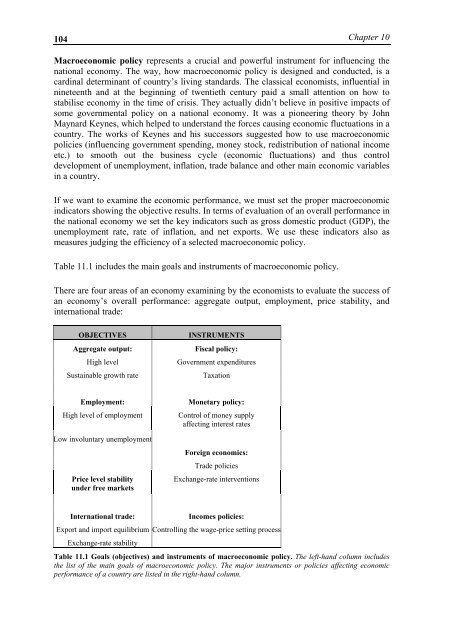MacroeconomicsI_working_version (1)
You also want an ePaper? Increase the reach of your titles
YUMPU automatically turns print PDFs into web optimized ePapers that Google loves.
104<br />
Chapter 10<br />
Macroeconomic policy represents a crucial and powerful instrument for influencing the<br />
national economy. The way, how macroeconomic policy is designed and conducted, is a<br />
cardinal determinant of country’s living standards. The classical economists, influential in<br />
nineteenth and at the beginning of twentieth century paid a small attention on how to<br />
stabilise economy in the time of crisis. They actually didn’t believe in positive impacts of<br />
some governmental policy on a national economy. It was a pioneering theory by John<br />
Maynard Keynes, which helped to understand the forces causing economic fluctuations in a<br />
country. The works of Keynes and his successors suggested how to use macroeconomic<br />
policies (influencing government spending, money stock, redistribution of national income<br />
etc.) to smooth out the business cycle (economic fluctuations) and thus control<br />
development of unemployment, inflation, trade balance and other main economic variables<br />
in a country.<br />
If we want to examine the economic performance, we must set the proper macroeconomic<br />
indicators showing the objective results. In terms of evaluation of an overall performance in<br />
the national economy we set the key indicators such as gross domestic product (GDP), the<br />
unemployment rate, rate of inflation, and net exports. We use these indicators also as<br />
measures judging the efficiency of a selected macroeconomic policy.<br />
Table 11.1 includes the main goals and instruments of macroeconomic policy.<br />
There are four areas of an economy examining by the economists to evaluate the success of<br />
an economy’s overall performance: aggregate output, employment, price stability, and<br />
international trade:<br />
OBJECTIVES<br />
Aggregate output:<br />
High level<br />
Sustainable growth rate<br />
INSTRUMENTS<br />
Fiscal policy:<br />
Government expenditures<br />
Taxation<br />
Employment:<br />
High level of employment<br />
Low involuntary unemployment<br />
Price level stability<br />
under free markets<br />
Monetary policy:<br />
Control of money supply<br />
affecting interest rates<br />
Foreign economics:<br />
Trade policies<br />
Exchange-rate interventions<br />
International trade:<br />
Incomes policies:<br />
Export and import equilibrium Controlling the wage-price setting process<br />
Exchange-rate stability<br />
Table 11.1 Goals (objectives) and instruments of macroeconomic policy. The left-hand column includes<br />
the list of the main goals of macroeconomic policy. The major instruments or policies affecting economic<br />
performance of a country are listed in the right-hand column.




